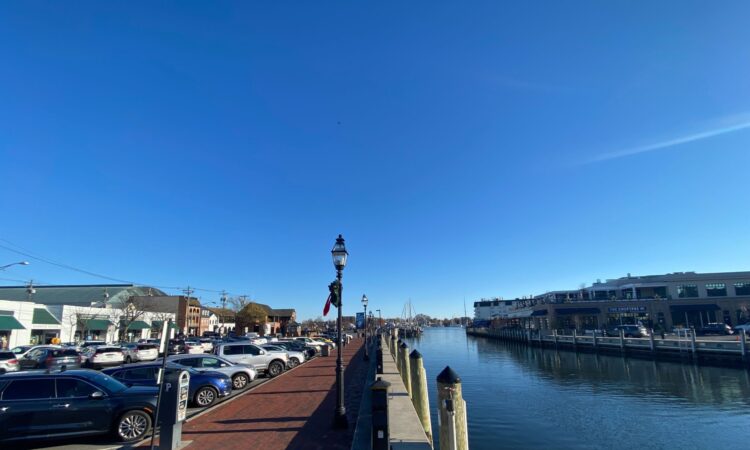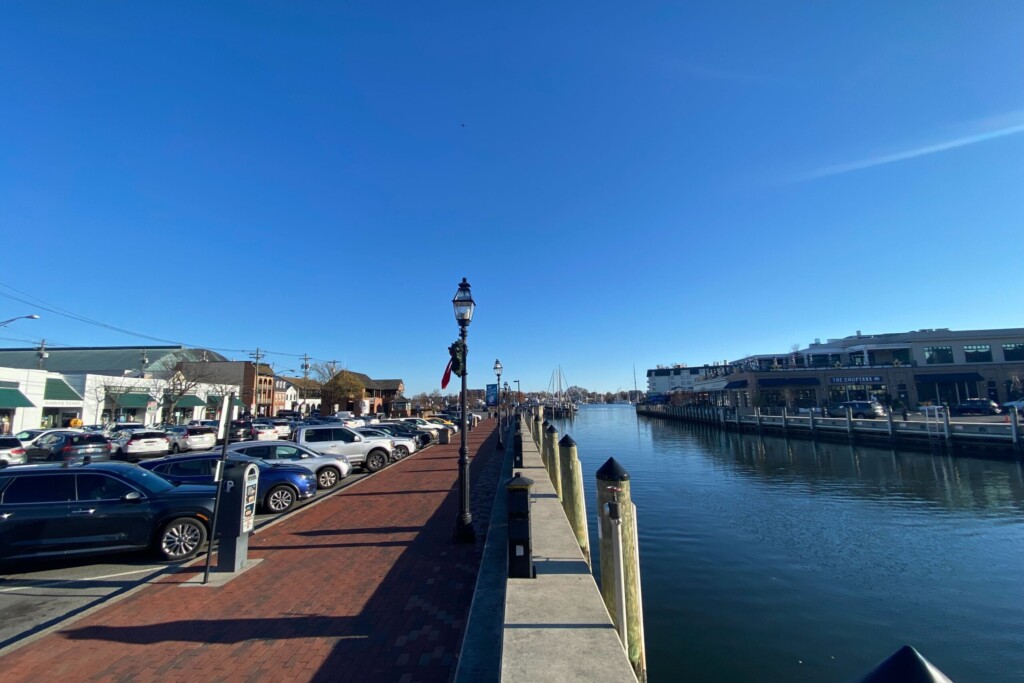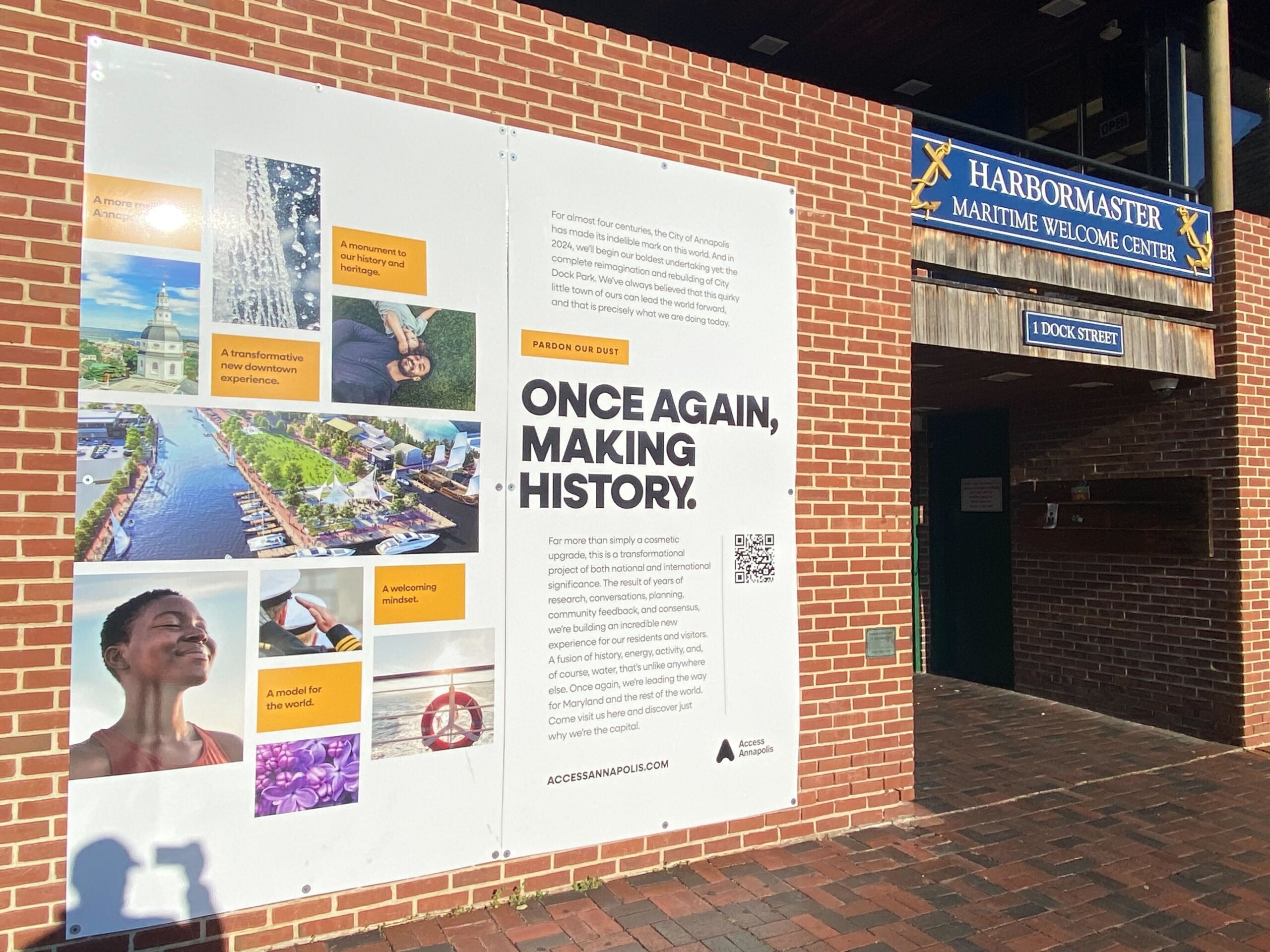

By John Domen
Downtown Annapolis floods a lot. Sometimes the flooding, classified as nuisance flooding, is just that, a nuisance that might get your shoes wet.
But there are times when the waters can rise several feet, surpassing sandbags set up in front of doorways on Dock Street, where business owners have to pump the water back out of their stores.
“I’ve been in my kayak and I paddled up to those businesses where we’ve had these big floods and looked in the window to see how many inches of water are the on the floors of Storm Brothers or Armadillos or Dock Street,” Annapolis Mayor Gavin Buckley said.
But in coming years, Buckley said, businesses won’t have to worry after a $90 million redesign of the downtown area: “They’ll be dry.’
About $30 million has already been spent to add more parking to a garage further up Main Street. More of the project will be paid for through congressional earmarks, on top of a substantial federal grant from Federal Emergency Management Agency.
Those additional parking spots will be needed since another parking lot that gets as busy as it gets wet is about to be history.
The lot, which runs parallel to the boat slips known as Ego Alley, is everything Buckley feels is wrong with the city’s efforts to combat the flooding that’s increasingly becoming a problem.
“No European city would have a parking lot on its waterfront the way we do,” said Buckley, who as it so happens, just got back from a trip to Europe to see what’s been done to make cities there more resilient to rising sea levels.
His trip to the Netherlands, where some cities sit below sea level, was eye-opening and also confirmed that what the city plans to do in the future will work, he said.
“A week ago, you couldn’t get across the Eastport Bridge because Compromise Street was closed off,” Buckley said. “Later the next day, the next tide that came in after that big one at night, shut down businesses on Dock Street. So it has a true economic effect on the businesses in this town. It affects the psychology of people coming into the town. It puts people off sometimes. And we’re going to fix that.”
What he saw in the Netherlands provided more proof to him that it can be done.
“The way they manage water, the way they tie it into public space, they have these beautiful parks that can flood and hold water for a day or two when they need to,” Buckley said. “There are these massive gates that lock off the harbor when they need to do it, when there’s a big superstorm coming their way. They have parking garages under sand dunes, and the parking garage is also a dike — it holds back water when it needs to hold back water, but at the same time, it stores cars. And then on top of it, there’s beautiful sand dunes. So it’s really, really natural.”
Buckley said the techniques to hold back water short term can be applied in a number of places in Annapolis.
“These sort of containers that they linked together to stop immediate flooding, they leak maybe 1% or 2% [of the time]. So they hold back 98% of the water, 2% of it leaks through. But that’s good enough in the short term,” Buckley said, especially in a city that has about 16 miles of waterfront land in total, though most of it is privately owned.
The most noticeable changes will start to become visible in the coming months, when a significant number of parking spots right on the water’s edge will give way to a giant, elevated park.

Phase one of the construction starts in the spring, with the parking lot getting closed off and redesigned into the park by the fall 2024. WTOP photo by John Domen.
Soon, all the land that surrounds Ego Alley will also be protected with flood gates that can come out of the ground. But the centerpiece, visually and environmentally, will be that park.
“It’ll absorb some stormwater,” Buckley said. “So that is also a barrier itself, the raised park. That’s at, I think about 8 feet (above sea level) and then it starts to go down and where there’s an opening, there’ll be like a pop-up, out-of-the-ground floodgate.” Currently the land is around 3 feet above sea level.
Phase One of the construction starts in the spring, with the parking lot getting closed off and redesigned into the park by the fall.
The following year, in the fall of 2025, the area around Ego Alley, including the Alex Haley statue, will be closed to pedestrians, so those flood gates can be installed. When the work there is done, around fall 2026, Haley’s vision as depicted on a painting on the wall of the Harbormaster’s Quarters will see families enjoying picnics, playing ping-pong, and attending any number of city events that just can’t be done on asphalt.
But Buckley also said sustainability and resilience will have to go beyond the redesign of downtown Annapolis, with the formation of even more environmentally friendly habits. And it has to go beyond more electric vehicles.
“I know it’s probably sounds crazy, but the answer is really simple,” said the mayor. “We have to learn to walk again. We have to realize that walking a quarter of a mile or a half a mile to a meeting is not a terrible thing. I mean, the city of Annapolis is a beautiful place to walk through. We have to realize that getting on a bike in the winter or in the rain is doable.”
Buckley himself is known for commuting most of the time on his bike.
“But I understand here, people don’t want to get on bikes because they don’t want to get killed,” he conceded. “So we have to build out the infrastructure. You have to have safe bike lanes and pedestrian lanes that are separated from cars, so people feel safe.”
Of course, in 2018, an attempt to add a bike lane up Main Street proved extremely unpopular to businesses, since it took away about half the parking spaces there. It was gone 10 days later.
However, a recent study found that more than half of all trips through Annapolis are less than three miles long still gives him hope that people might forgo their cars, at least sometimes.
“If you could do half of those trips, on a bike or walk or whatever, we would burn a lot less fossil fuel. We’d have a lot less traffic on the road,” he said, linking the rising sea levels and stronger storm surge that has caused an increasing number of problems to climate change. “We’d have a much better quality of life and a much healthier population.”
But Buckley also believes that what he saw in Europe, and what’s about to begin right on the water’s edge of the city, will also be copied in other communities around the country.
“So this is about being prepared,” Buckley said. “We’re proud that the city of Annapolis is going to be a lot further along than a lot of places in America. And I think people in our country are going to come in and look at what we’ve done and they’re going to learn from us.
Buckley touts Annapolis as beautiful waterfront city.
“The water is one of our biggest economic drivers. It’s what makes this city so livable. But also it’s one of our greatest threats,” Buckley said.
As part of Maryland Matters’ content sharing agreement with WTOP, we feature this article from John Domen. Click here for the WTOP News website.






